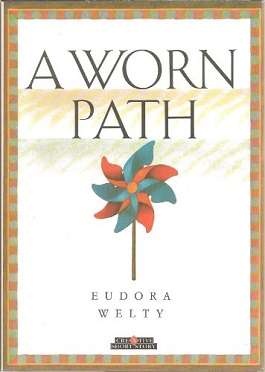A Worn Path
"A Worn Path" by Eudora Welty is a short story about an elderly African American woman who undertakes a familiar journey on a road in a rural area to acquire medicine for her grandson. She expresses herself, both to her surroundings and in short spurts of spoken monologue, warning away animals and expressing the pain she feels in her weary bones.
| "A Worn Path" | |
|---|---|
 1991 publication | |
| Author | Eudora Welty |
| Country | USA |
| Language | English |
| Published in | Atlantic Monthly, vol. 167, no. 2[1] |
| Publication type | Magazine |
| Media type | Short story |
| Publication date | February 1941 |
Plot
"A Worn Path" is told in the third person point of view.[2] In which "A Worn Path" follows an elderly African American woman named Phoenix Jackson as she ventures toward a town.[3] The story is set in "Natchez, Mississippi" during the Great Depression era.[4] As Phoenix journeys along the Natchez Trace, she periodically encounters many obstacles, including thorny bushes, barbed wire, and a large dog, among others. She meets a hunter, pocketing a nickel that he drops, and a lady who ties her shoes. The story concludes with Phoenix arriving at the town having completed the journey yet again. Her motivation for having done so is also revealed as she laments how her grandson swallowed lye damaging his throat from the reaction. She tells the nurse supplying the medicine that the damage to his throat never fully heals, and every so often his throat will begin to swell shut. It is Old Phoenix's love for her grandson that causes her to face the trial of the journey to town, every time it is necessary, with no questions asked.
Character
The character of Phoenix Jackson is an elderly African American woman who uses a thin small cane made from an umbrella to tap the ground, akin to a white cane. Elaine Orr identifies Phoenix as a fabulist who has "a penchant for re-creation (making up stories) rather than resolution."[5]:58 She has also been identified as "a completely and beautifully harmonious person" and Nancy K. Butterworth has noted that the character is neither a stereotype or stock character.[5]:59
Themes
A commonly cited theme of the story is unselfish love, which Orr has stated is the ""charitable" view of Phoenix that the white community in the text finds acceptable".[5]:59
The short story also discusses racism and the arrogance it breeds by marginalising other people and being cruel to them. However, another theme of the story is the ability of the human spirit to endure conflict and poor circumstances within nature and society out of devotion to loved ones.[6]
Symbolism
The symbolism in the piece and the potential lessons to be learned from it are open to interpretation. Many critics have commented on the significance of the main character's name in relation to the mythology phoenix, relating to her indomitable ability to rise again and make her journey.[7][8] Other writers such as Dennis Sykes and Kevin Moberly have argued that Phoenix's endurance through multiple obstacles emphasizes racial and economic inequalities in the Deep South during the Depression.[9][10] Kathleen Feeley has drawn comparisons to the story of Odysseus, who faces many trials along his journey.[11] Welty herself has said it is a story about how a writer works.[12]
Mistletoe is seen as a symbolic item by David Piwinski, who states that the plant is affiliated with "Jesus Christ" implying how Phoenix herself Is a "Christ-like figure" who repeatedly overcomes adversity.[13] Similarly, Piwinski notes how mistletoe is specifically an "evergreen" which may "allude to the idea that (Phoenix) is an immortal figure".[13] Orr states that the cycle culminates for Phoenix herself in the form of the lye/damage/obstacles representing the death that the cycle begins with while the journey and destination relate to the subsequent rebirth and that the money has meaning behind it with the nickel that she stole from the ground that the hunter dropped, can say that she find and takes what she needs when she needs it.[5]
References
- A Worn Path. OCLC Worldcat. OCLC 34694187.
- "Examples of Writing in Third Person". YourDictionary. Retrieved 2019-02-14.
- Dazey, Mary Ann (February 1979). "Phoenix Jackson and the Nice Lady: A note on Eudora Welty's "A Worn Path"". American Notes & Queries. 17 (6): 92–93.
- "Character in Place: Eudora Welty's "A Worn Path"". edsitement.neh.gov. Retrieved 2019-04-16.
- Orr, Elaine (1992). "Unsettling Every Definition of Otherness': Another Reading of Eudora Welty's 'A Worn Path". South Atlantic Review. 57 (2): 57–72. doi:10.2307/3200218. JSTOR 3200218.
- "A Worn Path Themes - eNotes.com". eNotes. Retrieved 2016-11-01.
- Piwinski, David J. (Winter 2003). "Mistletoe in Eudora Welty's "A Worn Path"". ANQ. 16 (1): 40–42. doi:10.1080/08957690309598188.
- Bartel, Roland (Summer 1977). "Life and Death in Eudora Welty's "A Worn Path"". Studies in Short Fiction. 14 (3): 288–290.
- Sykes, Dennis J. (Spring 1998). "Welty's The Worn Path". Explicator. 56 (3): 151. doi:10.1080/00144949809595296.
- Moberly, Kevin (December 1, 2005). "Toward the North Star: Eudora Welty's "A Worn Path" and the Slave Narrative Tradition". Mississippi Quarterly. 59 (1/2): 107–127.
- Feeley, Kathleen (15 October 2001). "Remembering Eudora Welty". America. 185 (11): 13–15.
- Welty, Eudora (1974). "Is Phoenix Jackson's Grandson Really Dead?". Critical Inquiry. 1 (1): 219–221. doi:10.1086/447784. JSTOR 1342926.
- "Mistletoe in Eudora Welty's 'A Worn Path'". login.ezproxy.mga.edu. Retrieved 2019-04-16.
